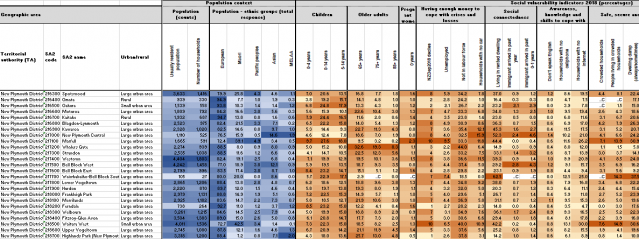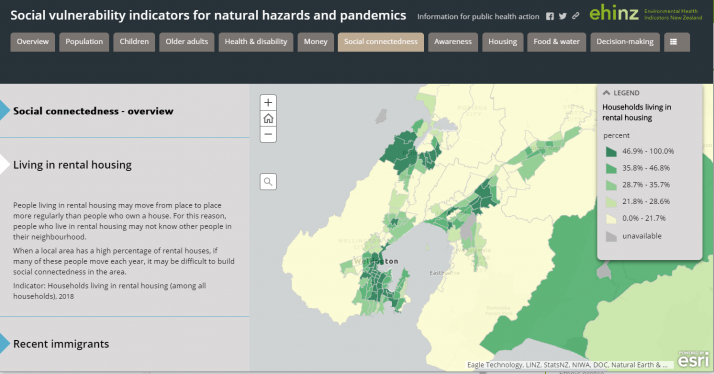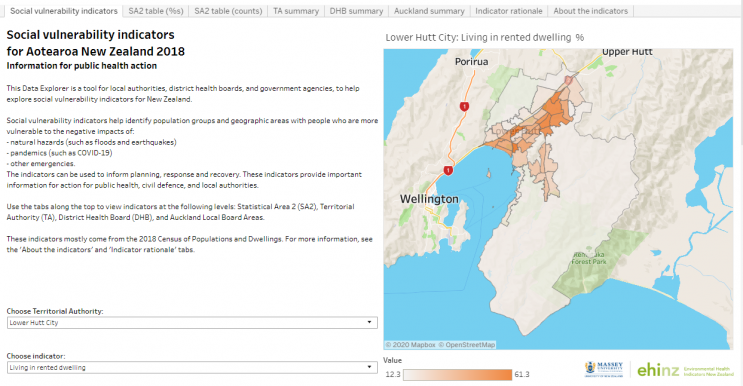Social vulnerability indicators for 2018
On this page:
About the social vulnerability indicators for 2018
Vulnerable people are more likely to be affected by a hazard. They may be less able to prepare for, cope with or adapt to a hazard.
Social vulnerability indicators identify populations and geographic areas that are more vulnerable to the negative impacts of natural hazards and climate change. These hazards include: floods, heatwaves, wildfires, earthquakes and tsunami, as well as other hazards and emergencies such as climate change impacts and pandemics.
The indicators were first developed for social vulnerability to flooding, by EHINZ in 2019. This project tested the indicators using a case study of Porirua, Wellington. Since then, we have updated the indicators with 2018 Census data.
Indicator data is available for small areas (SA2s), territorial authorities, districts (formerly district health boards), and Auckland local board areas. These indicators provide valuable information for action for the health sector, local authorities, and government agencies.
You can explore the indicators with our interactive map, regional heatmaps, and Excel datasets.
What topics do the SVIs cover?
The indicators cover the following dimensions of social vulnerability:
- Population and households
- Children
- Older adults
- Health and disability status (pre-existing health conditions, other physical and/or mental health needs, disability) (in development)
- Money (having enough money to cope with losses)
- Social connectedness
- Awareness of hazards (awareness, knowledge and skills to cope with hazards)
- Housing (safe, secure and healthy housing)
- Emergency supplies (having enough food and water to cope with shortage)
- Decision-making and participation
- Occupation
See the list of 2018 social vulnerability indicators.
Explore online map of Social Vulnerability Indicators 2018
This Story Map lets you explore interactive maps of the Social Vulnerability Indicators for New Zealand for 2018.
Indicators are presented for each dimension of social vulnerability. Rationale is included about why the indicators are important for social vulnerability. Indicators are mostly presented at the Statistical Area 2 (SA2) level (neighbourhood level).
Visit the Story Map for the Social Vulnerability Indicators for New Zealand 2018
Regional heatmaps
Regional heatmaps present social vulnerability indicator data ‘at a glance’, for small areas and geographic regions across New Zealand.
Figure 1: Example of social vulnerability indicators 'heatmap'

Summary heatmaps show the social vulnerability indicators at a regional level:
- Heatmap by district (formerly District Health Board) (Dec 2021) (pdf, 193KB)
- Heatmap by territorial authority (Dec 2021) (pdf, 397KB)
- Heatmap of languages spoken, by territorial authority (Dec 2021) (pdf, 326KB)
Heatmaps are also available for each Civil Defence and Emergency Management (CDEM) region. These heatmaps are based on territorial authority, and have data at the SA2 level:
- Northland region (Dec 2021) (pdf, 551KB)
- Auckland region (Dec 2021) (pdf, 2677KB)
- Waikato region (Dec 2021) (pdf, 1159KB)
- Bay of Plenty region (Dec 2021) (pdf, 767KB)
- Tairawhiti region (Dec 2021) (pdf, 246KB)
- Hawke's Bay region (Dec 2021) (pdf, 533KB)
- Taranaki region (Dec 2021) (pdf, 376KB)
- Manawatu-Whanganui region (Dec 2021) (pdf, 741KB)
- Wellington region (Dec 2021) (pdf, 1063KB)
- Nelson-Tasman region (Dec 2021) (pdf, 362KB)
- Marlborough region (Dec 2021) (pdf, 219KB)
- West Coast region (Dec 2021) (pdf, 239KB)
- Canterbury region (Dec 2021) (pdf, 1460KB)
- Otago region (Dec 2021) (pdf, 687KB)
- Southland region (Dec 2021) (pdf, 359KB)
Excel datasets and metadata
Excel datasets are available with all the underlying data from the interactive maps and regional heatmaps.
Social vulnerability indicators 2018 - heatmaps by SA2 (Dec 2021) (xlsx, 4.2MB): This SVI heatmap dataset provides summary social vulnerability indicator data for 2018 by SA2. Tables are presented for Civil Defence regions and territorial authorities.
Social vulnerability indicators 2018 - full indicator dataset (Dec 2021) (xlsx, 8.5MB): This dataset provides the full set of social vulnerability indicators for 2018, by SA2, territorial authority, Auckland local board areas, and district (formerly District Health Board) (where possible). The indicator dataset includes counts, denominators, and percentages. It also includes information about missing data, data quality, and logical bounds for percentages where applicable. Data about population demographics are also included. The indicator data comes mainly from the 2018 Census.
Metadata for social vulnerability indicators SVI2018 (Dec 2021) (pdf, 236KB): This document provides details of the SVI2018 dataset, as at December 2021. This includes definitions of individual indicators, and a summary of the information in the indicator dataset.
Data Explorer
This Data Explorer is a tool for local authorities, the health sector, and government agencies. This tool can help you explore social vulnerability indicators for New Zealand.
This tool presents the indicator data in interactive tables, heatmaps, and geographic maps. Indicator data is available at the SA2, territorial authority, district (formerly district health board) and Auckland local board area level.
Visit the Data Explorer for the Social Vulnerability Indicators for New Zealand 2018
Geospatial data - REST service
The social vulnerability indicators are available as an ArcGIS Online REST service. These data are for 2018, and are at the SA2 level. View the REST service.
Shapefiles for the social vulnerability indicators 2018 are also available upon request. Please email Kylie Mason (k.mason@massey.ac.nz) or the EHI team (ehinz@massey.ac.nz).
Full list of the social vulnerability indicators for 2018
The list below provides the social vulnerability indicators for flooding. Data for these indicators are currently available for 2018. Data are available at the geographic levels of SA2, territorial authority, district (formerly district health boards) and Auckland local board areas.
|
Exposure |
Usually resident population Number of households Population density People living in rural areas Population by ethnic group (total response): European, Māori, Pacific peoples, Asian, Middle Eastern / Latin American / African (MELAA) |
|
Children |
Children aged 0–4 years Children aged 0–14 years Children aged 5–14 years Households with at least one child aged 0–4 years Households with at least one child aged 0–14 years |
|
Older adults |
Older adults aged 65+ years Older adults aged 75+ years Older adults aged 85+ years Households with an older adult (65+ years) living alone |
|
Physical health needs |
Pregnant women (proxy of babies aged <1 year) |
|
Having enough money to cope with crises/losses |
Socioeconomic deprivation (NZDep2018) Unemployed people People who are not in the labour force Single parent households Households with no car |
|
Social connectedness |
Households living in rented dwelling One-person households Immigrant arrived in past year Immigrant arrived in past 0-1 years |
|
Awareness, knowledge, and skills to cope with hazards and emergencies |
People who don’t speak English Households with no mobile phone Households with no internet Recent immigrants |
|
Safe, secure and healthy housing |
Crowded households People living in crowded households Dwelling damp (always/sometimes) Dwelling damp (always) Dwelling mouldy (always/sometimes) Dwelling mouldy (always) |
|
Enough food and water to cope with shortage |
Socioeconomic deprivation (NZDep2018) Living in rented dwelling Dwellings with no access to safe running water Dwellings with no access to a fridge Dwellings with no access to electricity |
|
Decision-making participation and leadership |
Voter turnout in local body elections (TA-level only) |
|
Occupation |
Healthcare and social assistance workers Primary industry workers |
For more information, see the metadata document.
Information about the 2018 indicator data
Data for the Social Vulnerability Indicators 2018 come from the 2018 Census of Populations and Dwellings, the 2018 New Zealand Index of Deprivation (NZDep2018) [1], and local body election voter turnout statistics. This work includes customised data from Stats NZ, which are licensed by Stats NZ for re-use under the Creative Commons Attribution 4.0 International licence.
Indicator data is mainly sourced from the 2018 Census. Therefore the data may not accurately reflect current reality, and should be interpreted with caution. However, other data can be used to supplement this data when available.
The 2018 Census suffered from implementation problems, resulting in lower response rates than expected. Given this, we have only used data of at least moderate quality (as determined by Stats NZ and the External Data Quality Panel) that we also considered would be of sufficient quality at the small area level. We have also included information about data quality for indicators. For indicators with missing data, the dataset includes the counts, percentages among the total stated, unknown counts, and the lower and upper bounds of the percentages.
The indicator data is available as both counts and percentages in the full Excel dataset. Counts are useful for understanding the overall number of people (or households) affected. However, some indicators have some missing data, so counts will underestimate the true population affected. Given this, the main outputs for the 2018 indicators (heatmaps and online maps) present percentages only.
For more information, see the metadata document.
References
1. Atkinson J, Salmond C, Crampton P. 2019. NZDep2018 Index of Deprivation, Interim Research Report, December 2019. Wellington: Department of Public Health, University of Otago, Wellington.


